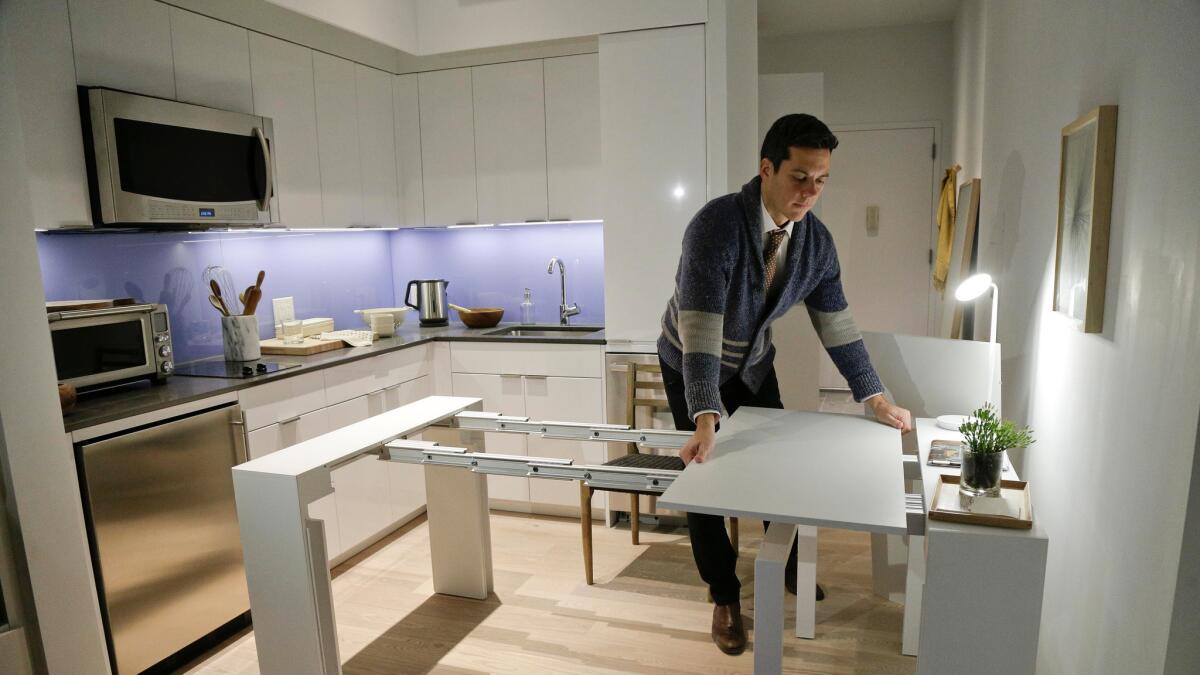Opinion: Cities once regulated micro-apartments out of existence. Let’s not make the same mistake twice

Cities across America are facing a devastating housing affordability crisis. And yet one obvious potential solution is facing a backlash in cities like Seattle and even dense parts of L.A. County: micro-units.
Broadly defined as living spaces under 350 square feet, micro-units are an old idea being revived with new twists. Previously known as efficiency apartments, they are today’s successors to the boardinghouses of old — where residents often lived in retrofitted mansions or hotels and shared one bathroom per floor with a common kitchen.
Narratives of mid-century America often reference this sort of boardinghouse or hotel living — from the bohemian adventures of Jim Morrison and the Beat Poets, to Grace Kelly, Lauren Bacall and Sylvia Plath, who stayed at the Barbizon, a long-term hotel for women. And yet, decades ago, in cities across America, such spaces were effectively regulated out of urban life.
Before we can understand why they are returning now, it’s important to understand why they were prohibited.
The 1960s and ’70s were a time of misguided planning policies that made cities less livable, constrained housing supply, and drove rental prices higher. Across the United States, many cities enacted laws that directly or indirectly targeted boardinghouses. A common ordinance was to declare any dwelling with five or more unrelated women living together a brothel. In addition, new building codes were developed that required larger minimum unit sizes, and prohibited the development or conversion of buildings into entirely small units.
Under these regulations, larger rooms mean higher rents.
This pattern was echoed in the suburbs, where larger minimum house and lot sizes forced the entry point of home ownership (and rental) higher. People were required to purchase or rent more home and land than they needed — and as a result had higher monthly costs to heat, cool and maintain the larger spaces.
In hindsight, these policies seemed intended to create economic segregation — raising the bar for living in an area by removing the most affordable housing options. They were enacted at a time of post-World War II economic growth, when the middle class was beginning a long period of prosperity and increased purchasing power. It was also a time of institutionalized racism and distrust of artists as Communists, and a time when the affordability and excitement of cities was still largely unappreciated.
So why are micro-units finally returning to popularity?
A lack of affordable urban housing obviously plays a role. But, beyond that, today’s economic uncertainty and job instability is also leading many who can afford larger residences to reconsider the wisdom of throwing away hard-earned money on rent or committing themselves to longer-term leases. Additionally, other than their size, today’s micro-units bear little resemblance to the boardinghouses of old. One Santa Fe in the downtown L.A. Arts District offers a saltwater pool, yoga/Pilates studios, and an outdoor theater. Residents can leave their rooms without needing to leave the building.
Putting consumer psychology aside, there is a more pressing reason that micro-apartments are so popular: They are gold mines for developers and landlords. When regulations against minimum unit sizes are relaxed, developers can put more units into a building envelope. And because small spaces tend to rent for more per square foot than larger ones, the building generates significantly more revenue, even if the monthly rents per unit are relatively affordable.
At One Santa Fe, for example, a 343-square-foot unit rents for $1,915 per month, or $67/sq.ft. annually. Meanwhile, a top-floor two bedroom in pricey Santa Monica can ask $4,500 per month for 1,100 square feet — or $54/sq.ft. annually.
Can these micro-units address the housing shortage in Los Angeles and other cities? Absolutely. They’re offering housing at a price point that isn’t broadly available. They add density, without affecting the skyline. Adding density can in turn create a stable base of demand for dining, shopping, and entertainment to anchor a neighborhood. Additionally, micro-units don’t have to offer luxury amenities, and can potentially boost affordable housing supplies and living space for senior citizens.
So why are so many cities — even those with an affordability crisis — resisting this trend?
Micro-units do have shortcomings. Apartments under 400 square feet are better suited to individuals rather than those with partners or families. Santa Monica recently passed a law that limits micro-units to 15% of any building — claiming it would encourage developers to build more multi-bedroom units for families.
But enabling single people to live alone, rather than with a roommate, frees up existing multi-bedroom units for families. Also, if regulations against minimum unit sizes continue to be relaxed, the next iteration of micro-units could be built with families in mind. Imagine compact two-and three-bedrooms that are thoughtfully designed to maximize privacy and utility for a couple or family. Perhaps a 600-square-foot two-bedroom or an 800-square-foot three-bedroom — versus your typical 600-square-foot studio today. This could strike a balance that offers affordable rental and purchase options while offering developers a higher return.
Solving the housing crisis in the most desirable cities in the United States demands accommodating a range of housing options. The current backlash against micro-units isn’t helping anyone.
Constantine Valhouli is the co-founder of NeighborhoodX, a real estate research and analytics firm. You can follow him on Twitter at @c_valhouli and FB at facebook.com/valhouli.
Follow the Opinion section on Twitter @latimesopinion or Facebook
More to Read
A cure for the common opinion
Get thought-provoking perspectives with our weekly newsletter.
You may occasionally receive promotional content from the Los Angeles Times.










